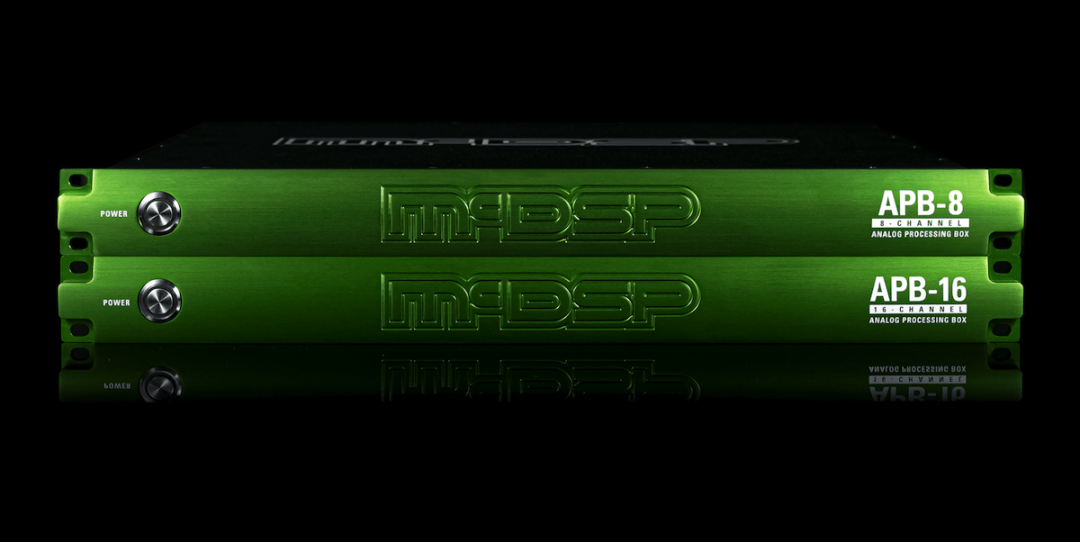McDSP’s APB-8 and APB-16 are truly unprecedented pieces of outboard equipment offering the sonic richness of analog with the unparalleled convenience of digital control. These one-of-a-kind processors may very well usher in a new era of hybrid analog-digital technology for enhanced sound quality and workflow efficiency.
What Is an Analog Processing Box (APB)?
An analog processing box is a singular McDSP development and a world-first. You can’t compare it to any other outboard gear, because no one else has done anything quite like it.
In one phrase, the APB is a programmable analog processor. That initially does little to demystify the device, but it will be a sufficient summation soon.
The analog processing box uses real analog circuitry, like any outboard processor, yet you’ll notice right away that it doesn’t have any knobs, buttons, or hands-on controls. That’s because you control the APB digitally through a plugin interface in Pro Tools.
When you load one of the 10 exclusive APB plugins, audio routes from the DAW to the analog circuitry inside the hardware. All processing is done in the analog domain, complete with saturation circuits and all that makes analog gear holy. The signal goes back to the plugin and outputs into the DAW from there. The APB is essentially 10 pieces of analog outboard equipment in a 1U rack chassis.
- RELATED: McDSP SA-3 Spectral Processor Review
The McDSP APB-8 Offers an Affordable Yet Powerful Analog Processing Box
Affordable is a relative term, but considering everything the APB-8 does, it’s definitely a powerhouse at a fraction of what it would cost to own 10 separate outboard processors. And that’s fundamentally where the magic lies in this machine; you get software control of analog hardware, which makes it possible for one device to perform multiple functions. As the name suggests, the APB-8 provides eight channels, though it’s possible to daisy chain APBs for expandability.
McDSP APB-8 Review
It Comes Loaded with Plugins
There are currently 10 plugins controlling the analog circuitry of the APB-8. These include a mixture of dynamics processors, EQ, and the impressive 8-channel Moo X Mixer. McDSP has released new plugins since the APB’s debut, so there’s reason to believe the library will continue to expand.
- Royal MU Compressor/Limiter
- Royal Q Equalizer
- MC-3 Multiband Compressor
- Moo X Mixer (world’s first hybrid mixing console under software control)
- C673-A Dynamic Range Compressor
- El Moo Tube Limiter
- Moo Tube Compressor
- ChickenHead Compressor
- L-18 Limiter and Surround Limiter
- C-18 Compressor
Sample Accurate Automation
Plugins parameters can be automated with sample-level accuracy. That’s a best-of-both-worlds situation in which you get the desired characteristics of analog with the precision of digital automation. It’s also worth noting that any settings can be saved as a preset, and recall is instantaneous when loading up a session. Again, the APB combines the efficiency of digital workflows with pure analog performance.
Hardware
The hardware itself contains all premium analog components, and each unit is manufactured in the United States. APBs are currently compatible with Thunderbolt 2, 3, and 4 — operable with the maximum speed and connectivity your computer provides. The rugged metal chassis is rock-solid, and the brushed green faceplate is an attractive addition to any rack.
McDSP APB-8 vs. APB-16: How Do They Compare?
Now comes the time to answer the titular question. How do the APB-8 and 16 compare, and which is better for you? Luckily, it’s pretty straightforward: the APB-8 has eight channels, and the APB-16 has 16. Where it gets somewhat tricky is that one plugin does not necessarily occupy one channel. In the case of the MC-3 Multiband Compressor, for instance, each band occupies its own channel on the APB. So one instance of the MC-3 would leave you with five remaining channels on the APB-8. This is certainly something to factor in when deciding between eight or 16 channels.
Choosing Between the ABP-8 & APB-16
The beauty of the Analog Processing Box is the ability to run multiple analog effects out of a single unit, but channels can disappear rather quickly in some instances. It’s a good idea to determine which of the plugins you find most attractive or useful given how you mix, and consider the ways in which you’d most likely apply them. That will help you decide whether you need more or fewer channels, and weighing the difference in cost between these units, a bit of research is encouraged.
- RELATED: McDSP APB-16 Review
Should you need to expand your APB channels down the line, they’re easily daisy chain-able. McDSP drivers automatically combine the total number of channels, so you never have to think about multiple APBs independently.
Closing Thoughts: Programmable Analog Processors Are the Future of Mixing
Coming up on four years since its release, the McDSP APB is still a remarkable tool. Nothing combines the convenience and precision of digital workflows with the organic-ness and musicality of analog processing. For any serious mixer, this is a total game-changer and is arguably indicative of where the future of hybrid analog-digital tech is headed. McDSP is surely spearheading the movement.
